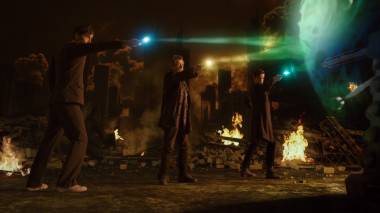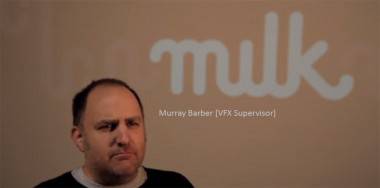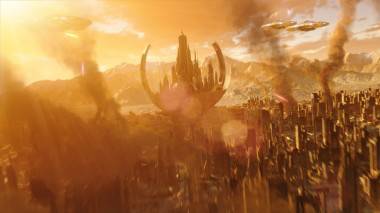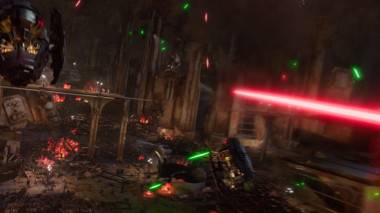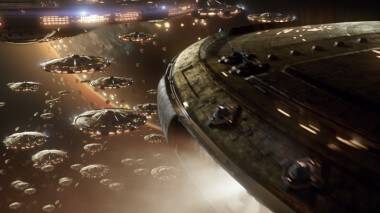Doctor Who: Day of the Doctors – A VFX Interview with Milk
WARNING! This article contains a fair few spoilers for the 50th Anniversary episode of Doctor Who; “The Day of the Doctors”. Seriously, if you haven’t seen it, order it now.
Watched it? Good, let’s continue. London-based Milk Visual Effects worked with the BBC to create the visual effects for the 75-minute special Doctor Who 50th anniversary episode. Shot in stereoscopic 3D, the episode was broadcast on BBC One in the UK on Saturday 23rd November achieving an average audience of 10.2 million and was simulcast in 94 countries and in more than 1500 cinemas across the world, winning a Guinness World Record as the largest simulcast of a TV drama in history and recently announced as the most watched TV drama of the year so far.
Milk were responsible for 129 VFX shots including the Dalek attack on the Gallifreyen city of Arcadia and the striking 3D Time Lord paintings at the National Gallery as well as working with the BBC’s Art Department to design the Dalek fighter pods, a brand new feature of the Dalek fleet, created especially for the episode. The team at Milk (previously as The Mill’s TV department prior to Milk’s launch in June 2013) has been creating the visual effects for Doctor Who since its regeneration in 2005. During this time, Doctor Who has gone on to become one of television’s most popular series in the UK and beyond and they have scooped a raft of awards including a BAFTA, a VES (Visual Effects Society) Award and an RTS Award for their VFX work.
I recently had the pleasure of interviewing the VFX Supervisor at Milk VFX, Murray Barber. A thoroughly decent guy who although up against it deadline-wise (the VFX for the Christmas episode were due for completion a couple of days after the interview) was kind enough to lend me a good half-hour of his time where we chatted about curse-word etiquette in phone interviews, the difficulty of working with 3D and ended with a slight threat against my life [jokingly I hope!] Please read on to see how it transpired.
What was the collaboration between Milk and the Director, Nick Hurran? Was he around for a lot of the VFX work?
Yeh, yeh we’ve worked with Nick before on past Doctor Who episodes and more recently on Sherlock. We know him really well and he’s really collaborative. He’s great. If you’ve got an idea, he’s open to it. You get some Directors who aren’t that open to ideas, but Nick is more, “What do you think about that?” “What’s your view on this?” He’s really good, I love working with him, he’s brilliant. Neville Kidd the DOP, he’s great as well. He did a tremendous job lighting the show.
The Battle of Gallifrey was suitably epic for the 50th Anniversary. Stylistically, what was your main influence for that?
Nick came up with a lot of stuff for that. Terminator was his main reference, how the battle scenes worked and what you actually see. Battlefields in general, just looking at stuff and seeing what you can get away with. Danny Hargreaves was doing all the SFX on it and just loves to blow things up [laughs]. A lot of it was just getting explosions and adding lasers to it, which the team in BBC Wales were responsible for. The fly-through shots were purely CG. We scanned the whole set and built it back here at MILK HQ.
The Dalek Pods drive a lot of the animation in those scenes, because we just want to be with them and fly around a bit. It’s a bit like in the Gulf War as well, when you hear about Exocet missiles going down a street or something like that. You don’t want to mimic that, but we did get a lot of inspiration from it. So, you know, we’re flying down the street and you’ve got people running from them on the bridge…just carnage really. Trying to make it as big and as epic as possible. You only get one chance to work on the 50th [anniversary episode] so you want to pull out all the stops and obviously for us at Milk it was our first big job and we just wanted to throw the kitchen sink at it.
It was very noticeable in the episode and was commented on in a lot of reviews, that you could actually follow what was happening in the battle-scenes, in contrast to a lot of recent Hollywood block-busters, that get a little muddled narratively in their big battle-scenes.
Ha yeh, in those other films they probably just stick loads of motion-blur and camera-shake on because they probably run out of time [laughs]. Thing is, you want to be able to see what’s going on, because it’s so cool! You have lasers coming at camera so the 3D effect is great, you get really immersed in it…you’re ducking in your seat! It’s just good fun really.
Yes, and that’s what you take away from the episode as a viewer, it was fun, it was enjoyable. You got a sense that the cast and crew had fun working on it.
It was! You know, it was stressful as times, like most shows are…because it was 3D as well, with the problems that throws up, it’s not as straight forward as a normal 2D show. The little tricks like scaling down plates and using 2D elements from other sources, you can’t do that anymore. They’re not problems as such, just little things that in 2D would take you a day, in stereo they take two and half.
That was one of my questions, does working in 3D impose any particular limitations on your normal pipeline?
It doesn’t help. Rendering for instance, everything needs to rendered twice. It’s just trickier, you know? Also you’ve got all your alignment fixes to do as well and all the colour-correction fixes. Every single plate has to be colour-matched as you have two cameras and one of them is going through a mirror. Having said that, this show wasn’t that bad. We’ve worked on films that naturally were much bigger, but brought a lot more problems because of the sheer size of production. So our 3D experience has always been one of lots of fixes. So we were aware of what to expect. We told Marcus Wilson [Show Producer], in our experience of 3D stuff, put some money in your back-pocket for fixes, because there will be some [laughs] and there were, but not as many as we thought there would be.
Were there any shots that you just couldn’t get finished? Or completed the way that you originally intended?
I could still work on it now! I’m always fiddling and noodling with shots, but there comes a point where you have to say, “Ok this is as far as we can take it.” The budget isn’t endless.
The Dalek Saucers were updated and the new Dalek Pods created for the episode. How much design input did Milk get on these?
The Saucers were an old model and they hadn’t been updated when the textures moved from PAL to HD, but this time we added some details and features to them because we get a lot closer to them that ever before, so they had a fair bit of work done on them. The Pods were a design collaboration the BBC Art Department. They did a couple of designs and our Concept Artist, Grant, polished them up. We needed a vehicle to get the Daleks from the Saucers down to the planet surface, so we kind of envisioned these little sort of armoured personnel carriers. There’s a certain amount of design influence from Star Wars in there too.
What was the working relationship between Milk and the VFX team at BBC Wales like? What was it they provided for the show?
The team in Wales, we’ve worked with them for a number of years. They tend to do some of the smaller shots, a lot of the laser stuff for instance. It’s a costing thing, they worked on a lot of the stuff that was cheaper to do down there. They did a lot of the stuff in the [Gallifrey] War room, which I thought looked amazing, like the holograms on the table, all that sort of stuff. They looked amazing.
In that final shot, with the Dream-team line-up of all the Doctors [so far], how did you achieve the effect of mapping their heads onto the dressed stand-ins? Were they paintings of digital heads?
It was originally meant to be a pull-back shot, but we just didn’t have the time or budget to re-build their faces in 3D, so we were limited by the images we could get. Two of the images were in black and white, for William Hartnell and Patrick Troughton, so we had to colour those. The main problem with that shot was getting the lighting right. The lighting needs to be accurate because we have three real Doctors in there and a directional light source. It was really difficult actually. Two or three of them we really struggled with. When the Doctor walks through the TARDIS doors they were all dressed stand-ins, but all wearing the original costumes that we got from The Doctor Who Experience [in Cardiff Bay.]
One last question, what are you most proud of, as a company, in the episode?
[vimeo 80370941][Large exhale] I don’t know! There’s two shots…no three shots I really like. The up and over on Gallifrey, as we go up, over and then down on it, which was actually a test shot to test the lighting and rendering pipeline, but Nick really liked it and asked if he could have it. So that was a freebie shot [laughs] and then he asked if he could have some saucers in it and some lasers! [laughs] so we thought “Here we go!” That’s just Nick pushing to make things look great. I love that shot. The 3D Time Lord paintings, because conceptually they were difficult. Steve’s [Moffat] script described them in great detail but we had to remember that the vast majority of people would be watching this in 2D, so it was how do we make something appear 3D in 2D?
Also the fly-through shot as we come past the exploding Dalek and everything slows down was challenging and turned out great. The fly-through Gallifrey, with the Dalek-Pods and the people running on the bridge, that’s probably my favourite shot.
So what’s next for Milk? Obviously there’s the small matter of the Christmas episode.
Yeh, Christmas, just trying to get that done. It’s 2D so that makes life easier [laughs].
So basically, you guys know exactly what’s happening in the Christmas special? I’ve got friends that would kill to be part of this phone-call right now!
[Laughs] I could tell you what happens but I’d have to kill you.
Murray, thanks for taking the time to answer my questions. Congratulations on the success of the 50th anniversary episode and good luck for the Christmas special and beyond.
Pleasure, thank you very much.
Milk is currently working on the BBC’s Doctor Who 60-minute special Christmas episode featuring Peter Capaldi as the new Doctor. The special episode will be broadcast on BBC One on Christmas Day. Milk’s current TV projects also include Sherlock: Series Three (Hartswood Films/BBC); new pirate drama series Black Sails for Starz; Sky’s New Year’s Day TV special – David Attenborough’s Natural History Museum Alive (Sky Atlantic); and the new TV drama Jonathan Strange & Mr Norrell, a seven part mini-series (7 x 60’) due to be broadcast on BBC One in the UK in 2015.
On the feature film side, Milk is working on MGM’s upcoming Hercules and has recently completed work on 47 Ronin for Universal. Milk has recently launched its new website www.milk-vfx.com
Items mentioned in this article:
![Doctor Who: The Day of the Doctor - 50th Anniversary Special [DVD]](https://www.skwigly.co.uk/wp-content/uploads/2013/12/Doctor-Who-The-Day-of-the-Doctor-50th-Anniversary-Special.jpg)


